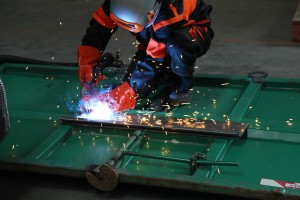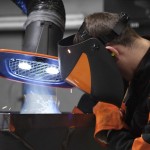New processes and materials in welding equals more safety? No!
New processes and additional materials promise a considerable reduction of the welding fumes. It is, however, a fallacy that the danger of a welding fumes explosion has been eliminated for the welder and work places surrounding him. On the contrary, the danger increases in the invisible area.
Further developed welding processes nowadays sometimes promise only half the emissions in welding. What at first sight provides the impression of increasing safety for the welder, proves to be an absolute fallacy at second sight. Suppliers of welding technology may be right on one issue: All in all, the amount of developing emissions in welding decreases by means of innovative processes. However, this does not apply in the nano range! In this range where the dangerous alveolar and ultra-fine welding fume particles bustle about, the health risk even increases.
 Compliance with the sequence of health and safety measures against welding fume particles is prescribed by law. All the same, further aspects must be taken into consideration: In order to ward off the danger of welding fumes, welders ought to carry out air pollution control measures by means of suction and filtering technology only after the selection of alternative welding processes or additional materials. However, the additional materials are actually the first and foremost safety hazard. Since the basic material only releases about five per cent of the total welding fume emissions, in the case of the additional materials only, this amounts to 95 per cent. Therefore the application of an effective suction and filtering technology must be used in any case.
Compliance with the sequence of health and safety measures against welding fume particles is prescribed by law. All the same, further aspects must be taken into consideration: In order to ward off the danger of welding fumes, welders ought to carry out air pollution control measures by means of suction and filtering technology only after the selection of alternative welding processes or additional materials. However, the additional materials are actually the first and foremost safety hazard. Since the basic material only releases about five per cent of the total welding fume emissions, in the case of the additional materials only, this amounts to 95 per cent. Therefore the application of an effective suction and filtering technology must be used in any case.
For this reason, it is necessary to warn against promises of less emissions. Investigations show that conglomerations of so-called primary particles in the welding fume are generally smaller than 1µm and that the majority of them are even smaller than 0.4µm. These are more dangerous than the already harmful alveolar welding fume particles. Because: The larger the particle conglomeration, the more probable it is that they will encounter other particles and be deposited there. If however, they are smaller, they can penetrate all the deeper into the human body. New welding processes may have further advantages as against the conventional processes,; however, an effective suction and filter technology is always recommended in the light of an increasing concentration of ultra-fine welding particles.





